With college football season upon us, it becomes easier again. I have 34 down, 16 to go. Number 35 is Delaware. On Thursday, August 31, the Fightin' Blue Hens -- I'll explain later -- will host Delaware State in their season opener.
Before You Go. We're talking about a place that's within a 3-hour drive, so the weather will be, essentially, the same as it is in New York whenever you go.
Delaware is in the Eastern Time Zone, so you won't have to adjust any timepieces.
Tickets. Delaware Stadium seats 22,000, and the UD football team is the most popular sports team in the State, making it the 4th-largest "city" in the State, behind Wilmington, Dover, and the rest of Newark. They are the only NCAA FCS (what used to be named Division I-AA) team to average more than 20,000 fans a game every season since 1999. So getting tickets might be an issue.
Prime Reserved, Sections D and K, midfield on the west and east stands, respectively, cost $35. Preferred Reserved, Sections C, E, J and L, between the 20-yard lines, are $30. Sideline Reserved are $20. General Admission, the north end zone, are $15.
Getting There. It's 134 miles from Times Square in Midtown Manhattan to Delaware Stadium in Newark, Delaware. The driving directions are not hard: Take the New Jersey Turnpike South, all the way to the Delaware Memorial Bridge, take the Delaware Turnpike to Exit 1B, to State Route 896 North, and you'll soon cross over State Route 4, the Christina Parkway, at which point the school's athletic complex will be on your right.
The Delaware Memorial Bridge, a.k.a. the Twin Span,
in a photo taken from the New Jersey side.
The eastbound lanes, on the left here, opened in 1951.
The westbound lanes opened in 1968.
It's too close to fly. Amtrak would be an issue, as this Newark, unlike New Jersey's, is not a priority station, with few trains stopping there in either direction. Round-trip fare is $117.
Greyhound doesn't go to Newark, Delaware: It goes to Wilmington, and you'd have to take a local bus, which would be fine for every home game after the season opener, but not that night, as the last bus from Wilmington back to New York would leave at 10:45 PM. It would cost about $60 round-trip. For a regular Saturday game, which they usually kick off at 3:30 PM, you'd take the Number 6 bus from the train station to Pomeroy Lane at Main Street, then either transfer to the Number 33 bus or walk the 2 miles south from the main campus to the stadium. The 2 buses would take an hour and 35 minutes. So, yeah, it's best to drive.
Once In the State. Delaware calls itself "The First State." It was 1 of the Original 13 Colonies, and it was, indeed, the 1st State to ratify the Constitution of the United States, on December 7, 1787.
The 2nd-smallest State by area (ahead of only Rhode Island), Delaware is 96 miles from north to south, 30 miles from east to west at its widest point, and only 16 miles from the Delaware Memorial Bridge to the Delaware-Maryland Line. It is home to just under 1 million people, most of whose sports tastes run toward Philadelphia, but a few, in the westernmost and southernmost areas, support the Baltimore Orioles and Ravens.
Until New Jersey's latest design,
Delaware was the only State with flat license plates.
Thomas West, 3rd Baron De La Warr (and that's pronounced the same as the State, "DELL-ah-where"), was the 1st colonial Governor of Virginia, and the later colony of Delaware was named for him. The name De La Warr could be an anglicization of "La Guerre," meaning "the war."
The Dutch settled first, at Lewes, in 1631. In 1638, New Sweden (including some of what became South Jersey) was established at Fort Christina, named for the Queen of Sweden famously played by Sweden's own Greta Garbo in the 1933 film Queen Christina. Fort Christina became Wilmington. The Dutch founded New Castle in 1651 and conquered New Sweden in 1655, annexing it to New Netherland, which included what became New York and New Jersey. But the English conquered New Netherland in 1664, including what became Delaware.
The peninsula from which Delaware extends, including the Eastern Shore of Maryland and Cape Charles, Virginia, is named Delmarva for all 3 States. It is considerably more conservative, and Southern in style, than the Northeast Corridor that includes Wilmington, Newark, Baltimore, Washington and Virginia's D.C. suburbs. Rehoboth Beach, Delaware's main shore town, is an exception, the former Methodist camp site (as was Ocean City, New Jersey) being welcoming to all, and having a notable gay community.
The definition of the northern boundary of the State is unusual. Most of the boundary between the States of Delaware and Pennsylvania was originally defined by an arc extending 12 miles, a.k.a. the Twelve-Mile Circle, from the cupola of the courthouse in the city of New Castle.
This border extends all the way east to the low-tide mark on the New Jersey shore of the Delaware River, then continues south along the shoreline until it again reaches the 12-mile arc in the south. Then the boundary continues in a more conventional way in the middle of the main channel of the river.
For this reason, from the Pennsylvania-Delaware line on south, the border between New Jersey and Delaware is not the middle of the River, but the edge of New Jersey's shore. And for that reason, there are 2 places in Salem County in mainland New Jersey that are officially part of Delaware, because they are the result of landfill: A section of Pennsville, known as the Delaware River Nature Reserve, west of Supawna Meadows National Wildlife Reserve and Finns Point National Cemetery (its mailing address is New Castle, DE); and an artificial island jetting north from Hope Creek Generating Station, a nuclear power plant, in Hancocks Bridge, known as "The Baja" (its mailing address is Middletown, DE), and a haven for local young miscreants.
To the west, a portion of the arc extends past the easternmost edge of Maryland. The remaining western border runs slightly east of due south from its intersection with the arc. A section of land between the northwest part of the arc and the Maryland border, known as The Wedge, was claimed by both Delaware and Pennsylvania until 1921, when Delaware's claim was confirmed.
Delaware famously has no sales tax. Its leading newspaper is The News Journal, based in Wilmington. ZIP Codes in Delaware begin with the digits 197 for Newark and the area around the University, 198 for Wilmington and its suburbs, and 199 on south, including Dover and the beach towns. For the entire State, the Area Code is 302.
Downtown Wilmington
The State capital is Dover, near the center of the State, 53 miles south of downtown Wilmington, 44 miles south of the University in Newark, and 44 miles northwest of the Rehoboth Beach Boardwalk.
The State House, the Legislative Hall, in Dover
The largest city, Wilmington, is not a large city, with about 71,000 people. New Castle County, Delaware; Salem County, New Jersey; and Cecil County, Maryland are sometimes counted as Wilmington's "metropolitan area"; if so, that's a total of 720,000, over 10 times as many. But Wilmington counts as part of Philadelphia's metropolitan area.
Wilmington is centered on Rodney Square, bordered by 9th, 10th, King and Market Streets. The Square is dominated by a statue of Caesar Rodney, who famously rode 70 miles from Dover to Philadelphia through a thunderstorm, arriving at what is now Independence Hall covered in mud, without having removed his boots and spurs, because Delaware and thus the country as a whole needed his vote for independence. This image also appears on Delaware's State Quarter. A residence hall at the University of Delaware is also named for him.
Wilmington's street addresses go up, east and west, from Market Street, and north and south from Front Street, which becomes Martin Luther King Jr. Blvd. west of Market Street. In contrast, Newark -- and that's pronounced NOO-ark, almost with the accent on both syllables, unlike New Jersey's city, pronounced NOO-erk -- has as its centerpoint the intersection of Main Street (north and south) and College Avenue (east and west).
Delaware's bus service is called DART. A 1-County ride is $2.00, but an all-day pass can be bought for $4.20. From New Castle County, which includes both Wilmington and Newark, south to Kent and Sussex Counties, it's $2.00 per zone. Going from downtown Wilmington to the capital of Dover would be $6.00, while going all the way to Rehoboth Beach would be $10.00. In each case, that's one-way.
The only rail service, besides Amtrak's Northeast Corridor, is SEPTA service to and from Philadelphia, formerly known as their R2 Line (save your Star Wars references), now the Wilmington/Newark Line. It has stops at Newark, Churchmans Crossing, Wilmington and Claymont.
Union Station, Wilmington
Along with Maryland, Kentucky and Missouri, Delaware was 1 of 4 States that stayed in the Union during the American Civil War, despite still having slavery be legal there. And segregation was still the norm there into the 1960s. Wilmington was one of the cities that had race riots in the wake of the assassination of Martin Luther King in 1968.
Joe Biden, the State's most successful politician, told a story about the racial tensions in Wilmington. In 1962, he was a security guard at a swimming pool. Biden was white, but the pool was "for colored only." There was an all-black gang, nonetheless using the Italian name the Romans, and their leader was a man calling himself CornPop.
On this occasion, CornPop came to the pool, but disobeyed one of the rules: He refused to wear a bathing cap. When Biden saw him on the diving board, he shouted, "You! Off the board, or I'll come up and drag you off!" Invoking the name of a prominent female swimmer, he also called CornPop "Esther Williams."
Now, Joe wasn't an especially big guy. But he was a former high school football player. He was tough, his father having instilled him a classic lesson, "Joey, it's not whether you get knocked down, it's whether you get back up."
CornPop got down, but told Biden he would be waiting for him outside the pool. True to his word, he was waiting, armed with a straight razor, a nasty weapon, and accompanied by 2 flunkies. He didn't care what the guard's name or background were, only that he wanted to intimidate this white man who seemed to be in charge of black people.
Biden was no fool: He grabbed a chain, intending to use it as his weapon, if necessary. He walked over to CornPop, and told him that he had enforced the rule, that it applied to everybody, and it always would as long as he was in charge. But he also apologized for calling CornPop "Esther Williams."
CornPop said, "Okay," closed the razor, and walked away with his flunkies. Both men had backed down some, both men had mostly saved face, and it was settled peacefully.
Naturally, Republicans accused Biden of lying, making the story up. Except Richard "Mouse" Smith, who became President of the Delaware branch of the NAACP, said he was there that day, and said it happened exactly as Biden described it. And in 2016, an obituary was published for a man named William L. Morris, listing his nickname as "CornPop." So the story is almost certainly true. Today, that pool is open to all, and is named for Biden.
Public pools are important. But Delaware is known for its beaches. Rehoboth Beach is 92 miles southeast of both Wilmington Union Station and the University. Just to the north, Lewes, the Delaware end of the Cape May Ferry from New Jersey, begins a string of beach towns that includes, going north to south, Rehoboth, Dewey Beach, Bethany Beach, York Beach, Fenwick Island, and then, across the State Line in Maryland, Ocean City.
Rehoboth Avenue, terminating at the boardwalk and its gazebo
Francis Alison, a Presbyterian minister, opened "The Free School" in his home in New London, Pennsylvania in 1743. It was moved to become the Academy of Newark in 1769. Up until independence in 1776, the British government considered Delaware to be part of the Province of Pennsylvania, known as "The Lower Counties on the Delaware." For this reason, the Academy was denied a charter as a college.
It took until 1833 for the Delaware General Assembly to pass "An Act to Establish a College at Newark." Newark College opened the next year, and in 1843 it merged with the Academy of Newark in 1843, becoming Delaware College. It became the University of Delaware in 1921, and became coed in 1945 when it absorbed the Women's College of Delaware. In addition to the main campus in Newark, there are also campuses in Dover, Wilmington, Lewes and Georgetown.
Aside from football players I'll get to momentarily, notable sports personalities who were University of Delaware graduates include Baseball Hall of Fame pitcher Vic Willis, basketball star Elena Delle Donne, and 3 noteworthy Philadelphia Phillies: Former Phillies owner Bob Carpenter Jr. (his son Ruly is a Yale graduate), former pitcher and manager Dallas Green, and Dave Raymond, the original Phillie Phanatic, serving from 1978 to 1993. Dave was a punter for the Blue Hens, coached by his father, Tubby Raymond, more about whom shortly.
In other fields, UD graduates include:
* Politics: Signers of the Declaration of Independence Thomas McKean (Class of) 1750, Caesar Rodney 1750, George Read 1753; Vice President Joe Biden '65, and his wife Jill Biden '76; Senators Biden, Thomas Clayton 1799, Louis McLane 1807, George Riddle 1839, L. Heisler Ball 1882, Allen Frear '24, Cale Boggs '31; Governors Boggs, John McCullough 1855 (he served as Attorney General of California and later Governor of Vermont) and Chris Christie '84 (now closing his tenure as Governor of New Jersey, his wife Mary Pat Christie is Class of '85 and they met there).
Also, both 2008 major party Presidential nominees' campaign managers, David Plouffe and Steve Schmidt. Both left before graduating, though, and went back to get their UD degrees: Barack Obama manager Plouffe, who should have been Class of '85, got his in 2010; John McCain manager Schmidt '93 got his in 2013.
George Read is 1 of only 2 men to have signed the Petition to the King of 1774, the Declaration of Independence in 1776, and the Constitution of the United States in 1787. The other is Roger Sherman of Connecticut, who also signed the Continental Association in 1774 and the Articles of Confederation in 1781, and was part of the committee to draft the Declaration, along with Benjamin Franklin, Philip Livingston, John Adams, and the man who actually wrote it, Thomas Jefferson.
* Journalism: Pulitzer Prize-winning Washington Post writer David E. Hoffman '77; and 2 news TV news anchors in Philadelphia, from UD's Class of '94: Susan Barnett a former Miss Pennsylvania and news anchor at KYW-Channel 3's Eyewitness News; and Matt O'Donnell, morning news anchor at WPVI-Channel 6's Action News.
* Science: Robert W. Gore '59, inventor of Gore-Tex.
Going In. Delaware Stadium opened in 1952, and seats 22,000 -- far from acceptability in the NCAA's Football Bowl Subdivision (FBS, formerly named Division I-A), but ideal for the Football Championship Subdivision (FCS, formerly Division I-AA). The official address is 625 Marvin Drive, and is the centerpiece of an athletic complex that is separated from the main campus by the railroad. Parking is $15.
The field was switched to artificial turf in 2010, runs north-to-south, and in 2002 was named Tubby Raymond Field, a.k.a. "The Tub." Harold R. "Tubby" Raymond, now 90 years old, was an assistant coach from 1954 to 1965, and head coach from 1966 to 2001. He also coached baseball at the school from 1956 to 1964.
A Michigan native, he went to the University of Michigan, and gave Delaware the same uniform: Blue jerseys (a slightly lighter shade than Michigan's) with gold numbers and trim, and the "winged" helmet.
Food. The school's website advertises the following options at Delaware Stadium:
- Smoker Station: Open outside the southwest area of the stadium for the two hours prior to kick-off.
- Grotto's Pizza: Section C on the West Concourse & in the Northeast corner concession booth.
- Chick-fil-A: Section B on the West concourse.
- Fryer Trailer: Northwest corner (French Fries and Chicken Fingers).
- Botto's Italian Sausage: Section C on the West Concourse & in the Northeast corner concession booth.
- Vegetarian Options: In the northwest corner (salads, sandwiches, wraps, & fruit cups).
Team History Displays. The Blue Hens won small-school National Championships in 1946, 1963, 1971 and 1972; an NCAA Division II National Championship in 1979; and an NCAA Division I-AA National Championship in 2003. So that's 6 "National Championships." The 1971, '72 and '79 wins were won under Tubby Raymond, who is honored with a bust outside the stadium.
Currently a member of the Atlantic 10 Conference, the Blue Hens have won their league 16 times, 9 times under Raymond. There is no display showing these titles in the fan-viewable parts of the stadium.
Current Delaware players in the NFL include Super Bowl XLVII winners Joe Flacco and Gino Gradkowski of the Baltimore Ravens. Other noted UD players include 1980s Giants quarterback Scott Brunner (once Phil Simms' backup), 1990s Kansas City and 2000s Oakland quarterback Rich Gannon, 2000s Arizona tight end Ben Patrick, and 1980s L.A. Rams safety Ivory Sully. However, the most famous Delaware-born football player went to the University of Maryland, and starred for the Dallas Cowboys: Hall of Fame 1970s linebacker Randy White.
As a member of the Atlantic 10 Conference, Delaware maintains rivalries with Delaware State, Villanova, and the Virginia schools James Madison University and the College of William & Mary. Although Delaware State is slightly closer, 40 miles to 43, UD's biggest rivalry is "The Battle of the Blue" with Villanova, which is a national collegiate power in basketball but only Division I-AA/FCS in football. They play for the Battle of the Blue Trophy, and Villanova leads the rivalry 28-21-1.
Gino Gradkowski with the trophy in 2011
UPDATE: Through the 2018 season, UD now leads DSU 9-0, but trails Villanova 31-21-1.
There are 2 notable books about Fightin' Blue Hens football. After the 1979 title season -- his 3rd in the preceding 9 years -- the coach wrote Tubby: The Story of Coach Raymond and Championship Football at Delaware. And in 2002, Elbert Chance published 100 Plus: The Story of Delaware Football.
During the Game. You are a visitor, and not rooting for the visiting team. Act like you want to be invited back, and your safety will not be an issue.
As with Rutgers, the south stand is student seating, and, in connection with the "Hen" theme, it's called the Cock Pit. Save your jokes. The mascot is a blue hen named YoUDee, a variation on "UD." He has a "son" who sometimes mascots with him, Baby Blue. YoUDee has been elected to the Mascot Hall of Fame.
Baby Blue and YoUDee on Main Street in Newark
Why "Blue Hens"? Especially for the men's teams at the University? And why a chicken at all, with all that connotes -- especially one that wears yellow, a color that, like the term "chicken" itself, is associated with cowardice? Maybe it's a Small State thing: The only smaller State in area has its own breed, the Rhode Island Red. (Even though the University of Rhode Island's teams are called the Rams, and wear blue.)
The Blue Hen Chicken is common in Delaware, and in the War of the American Revolution, Colonel John Haslet commanded the 1st Delaware Regiment. One of the companies was from Kent County, and was sub-commanded by Captain John Caldwell, who ran cockfights, and brought his Blue Hen roosters with him to entertain the men. The Blue Hen rooster gained a reputation for toughness, as did the 1st Delaware itself, and the State and the Blue Hen became synonymous.
So, long after cockfighting became illegal in most of America (only in 2008 did Louisiana become the 50th and last State to ban it, and it's still legal in Puerto Rico, which is American soil), UD's teams are the Blue Hens, and there's nothing especially feminine or cowardly about it. See also: The University of South Carolina Gamecocks.
The fight song has the rather unimaginative title of "UD Fight Song." But it's pretty good:
And then we'll fight! fight! fight! for Delaware,
Fight for the Blue and Gold,
And when we hit that line, our team is there
with a daring spirit bold
And when we strike with might, let foes beware
Our glorious name we'll uphold
Fight for the Blue and Gold,
And when we hit that line, our team is there
with a daring spirit bold
And when we strike with might, let foes beware
Our glorious name we'll uphold
And then we'll fight! fight! fight! for Delaware,
Fight for the Blue and Gold,
Delaware will shine to-night,
Delaware will shine.
When the sun goes down and the moon comes up,
Delaware will shine.
And then we'll fight! fight! fight! for Delaware!
After the Game. Delaware is below the Mason-Dixon Line, and it was a slave State until 1865. But it was a Union State. And while this is further south than you're used to, we're not talking about a game in the Southeastern Conference. And while this is further west than you're used to, we're not talking about a game in the Big Ten. Even if UD is playing Delaware State or Villanova, you should be fine.Fight for the Blue and Gold,
Delaware will shine to-night,
Delaware will shine.
When the sun goes down and the moon comes up,
Delaware will shine.
And then we'll fight! fight! fight! for Delaware!
The UDairy Creamery is a 5-minute walk north of the stadium. If you're looking for something a bit more substantial than ice cream, you may have to go 2 miles north to the main campus. Main Street, between New London Road at the west and Chapel Street to the east has chains like Chik-fil-A, Brew HaHa!, Dunkin Donuts, Dairy Queen, Orange Julius, Taverna, Chipotle, Panera, Insomnia Cookies, Jimmy John's, Cheeburger Cheeburger and Starbucks; and old Delaware standbys like the Deer Park Tavern, Grotto Pizza, Del Pez Mexican Gastropub, the Stone Balloon, Klondike Kate's, and Catherine Rooney's (an offshoot of the main bar on Wilmington's Trolley Square, which is Delaware's leading bar to watch European soccer).
Sidelights. Going around Delaware Stadium, clockwise starting at north, are the University of Delaware Ice Arenas (apparently, more than one), the David M. Nelson Athletic Complex, Bob Hannah Stadium (baseball), Stuart & Suzanne Grant Stadium (track), the Bob Carpenter Center (arena), Fred P. Rullo Stadium (an artificial field for grass sports other than football), and athletic dorms.
The Bob Carpenter Center, named for the former Phillies owner and Delaware native, is home to the Delaware 87ers, named for 1787, the year Delaware became the First State. They are a D-League farm team of the Philadelphia 76ers.
Delaware's only other pro sports team is the Wilmington Blue Rocks, a farm team of the Kansas City Royals in the Class A Carolina League. They play at Judy Johnson Field at Daniel S. Frawley Stadium, which includes the Delaware Sports Hall of Fame. Johnson was a Negro League star, who was born on Maryland's Eastern Shore, and grew up in Delaware. Frawley was the Mayor who got the 6,404-seat ballpark built, opening in 1993. 801 Shipyard Drive, across from The Westin Wilmington. Bus 12 from Union Station.
The team is named for the blue granite found along Wilmington's Brandywine River. They won the Pennant in 1994, 1996, 1998 and 1999, and made the Playoffs as recently as 2015. There was a previous Blue Rocks franchise in the Interstate League from 1940 to 1952, and it won 4 Pennants in its 13 seasons. They played at 7,000-seat Wilmington Park, which was demolished in 1963. It's an industrial area now. 2900 Governor Printz Blvd., about 2 miles northeast of downtown. Bus 14.
Wilmington did, however briefly and however dubiously, have a major league baseball team once. They were called the Wilmington Quicksteps, and they played in the Union Association, a league which played just 1 season, 1884.
The Quicksteps won the Pennant of the Eastern League that year, but Henry Lucas, the UA's founder and the owner of its dominant team, the St. Louis Maroons, needed a team to take the place of the folded Philadelphia club. The Quicksteps joined, and it was a mistake: Given that the season that they'd signed for was completed, half their players considered their contracts no longer valid, and they jumped to other teams.
As a result, the rump team may have been the worst team in MLB history: They went 2-16 before folding. They played at Union Street Park, bounded by N. Union Street, W. 2nd Street, Lincoln Street and Lancaster Avenue, about 2 miles west of downtown. Bus 6 or 18.
According to an April 23, 2014 New York Times article, the Phillies, unsurprisingly, dominate Delaware baseball fandom. In Wilmington, the Phils have 72 percent of fans, the Yankees 12, the Boston Red Sox 5. In Newark, it's Phillies 66, Yankees 13, Red Sox 5. In Dover, further south and thus within Baltimore's range, it's Philllies 50, Yankees 14, Orioles 13. By the time you get down to Rehoboth Beach, it's close: Phillies 33, Orioles 30, Yankees 15. Even across the State Line, in Elkton, northeasternmost Maryland, the Phillies are preferred over the Orioles.
The September 2014 issue of The Atlantic shows roughly the same major league city allegiances for the NFL: The Philadelphia Eagles are the most popular team in New Castle County and Kent County, while the Baltimore Ravens are more popular in Sussex County.
An October 3, 2014 New York Times article showed college football allegiances. Since it only looked at the FBS (formerly known as Division I-A), the Fightin' Blue Hens are not a factor. So, naturally, the most-hyped school in the Northeast, Penn State, leads with 20 percent, despite the Joe Paterno-Jerry Sandusky scandal already having sunk in. With a large Catholic population, it's not surprising that the 2nd-most popular team is Notre Dame. The University of Maryland? Support for the Terrapins is not noticeable until you get to the Beaches, near the State Line, Ocean City, and the Eastern Shore.
A May 12, 2014 New York Times article is now way out of date, seeing as how LeBron James has gone back to the Cleveland Cavaliers, and we've seen the rise of the Golden State Warriors and the retirement of Los Angeles Lakers star Kobe Bryant.
But it gave the 76ers 24 percent of fandom in Wilmington, the Lakers 16, and the Miami Heat 13 -- meaning 47 percent, nearly a majority, is other teams. In Newark, it's almost the same: 76ers 24, Lakers 13, Heat 13. By the time you get to Dover, 75 miles from the South Philly sports complex, Sixer support collapses: They don't even make the Top 3, which is Lakers 18, Heat 17, Boston Celtics 11. In Rehoboth, it's Lakers 18, Heat 16, Celtics 12. Again, this was taken before LeBron went back to Cleveland, Kobe retired, and the Warriors got great.
According to a January 2016 Business Insider article, the Philadelphia Flyers are easily the most popular hockey team: Even in Rehoboth Beach, you won't find too many Washington Capitals fans; if Baltimore had an NHL team, maybe they'd make a dent in the Flyers' support, but they don't have one.
Delaware is a good museum State. In or near downtown Wilmington: The Delaware History Museum, 504 N. Market Street; Delaware Children's Museum, 550 Justison Street, a long right field home run from Frawley Stadium; Old Swedes Church, 606 N. Church Street, a reminder that England, France and Spain, were not alone in settling North America. (New Sweden also includes parts of South Jersey. The Dutch? Try Lewes.)
Further afield: Delaware Art Museum, 2300 Kentmere Parkway, Bus 28; Delaware Museum of Natural History, 4800 Kennett Pike, Bus 10; Nemours Estate, Alfred I. du Pont's mansion and gardens, 850 Alapocas Drive, Bus 28.
There are plenty of historic sites in old Delaware towns like New Castle in the north, Dover in the middle, and Lewes in the south. Bethel Heritage Museum in Bethel, in the southwestern corner, is like a mini-Williamsburg. The Colonial one, not the Hipsterville in Brooklyn.
I visited Lewes during Thanksgiving Weekend 2016. If your reason for visiting is that you're taking the Cape May-Lewes Ferry, by all means, park you car and walk around. But if your sole reason is to see the Cannonball House, which has a cannonball embedded in the brick from when the British Royal Navy shelled Lewes during the War of 1812, don't go. The house itself is okay to look at, but the "cannonball" is no bigger than a baseball, and it's so low on the building, you could easily miss it.
Neither Elvis Presley nor the Beatles ever performed live in Delaware. The State has never produced a President, either, although Joe Biden served in the U.S. Senate for 36 years, and then as Barack Obama's Vice President for 8 years. He is a University of Delaware graduate, Class of '65, although he went to law school at Syracuse.
Since he didn't get to become President, he won't get a Presidential Library. Since he's still alive, it's unclear whether -- and, if so, when -- his house in the Claymont section of Wilmington, near the Pennsylvania State Line, would become an official historic site.
Delaware's Uncle Joe
Delaware doesn't have any "tall buildings" as we understand that term. The tallest is River Tower at Christina Landing, just 341 feet high, at 105 Christina Landing Drive, across the river from downtown. A 509-football building, currently named only "1001-1011 Jefferson Street," for its downtown address, has been approved to surpass it, but it probably won't open until 2020 at the earliest.
Remember all those TV shows set in Delaware? Yeah, me neither. The think tank that produced the title character in the late 1990s NBC drama The Pretender was set in the fictional town of Blue Cove. Movies? Wayne's World joked about how there was nothing much to talk about in Delaware. Apparently, Fight Club was set in Delaware, and Tyler Durden's house was filmed in Wilmington... California. Anyway, we're not supposed to talk about it... although, by a weird coincidence, singer Meat Loaf, who isn't from Delaware (he's from Dallas), was in both Wayne's World and Fight Club.
*
Wayne and Garth were wrong. There's lots to see in Delaware. Including some good old-fashioned traditional college football. Check it out.




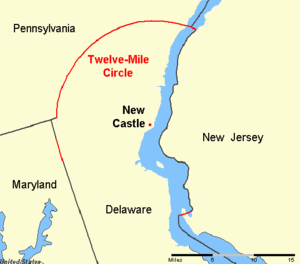


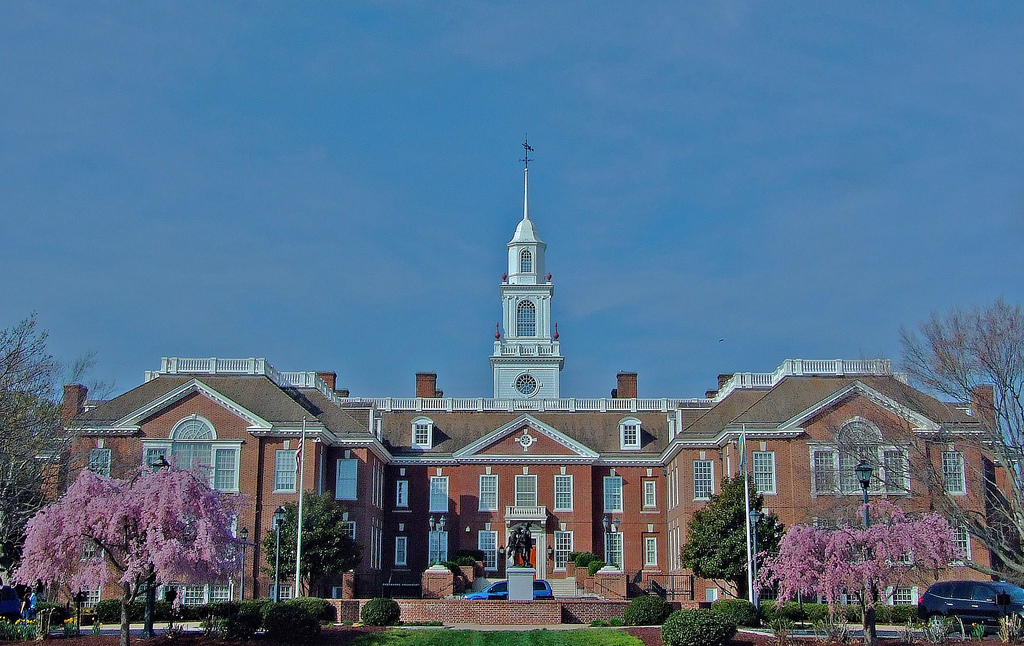

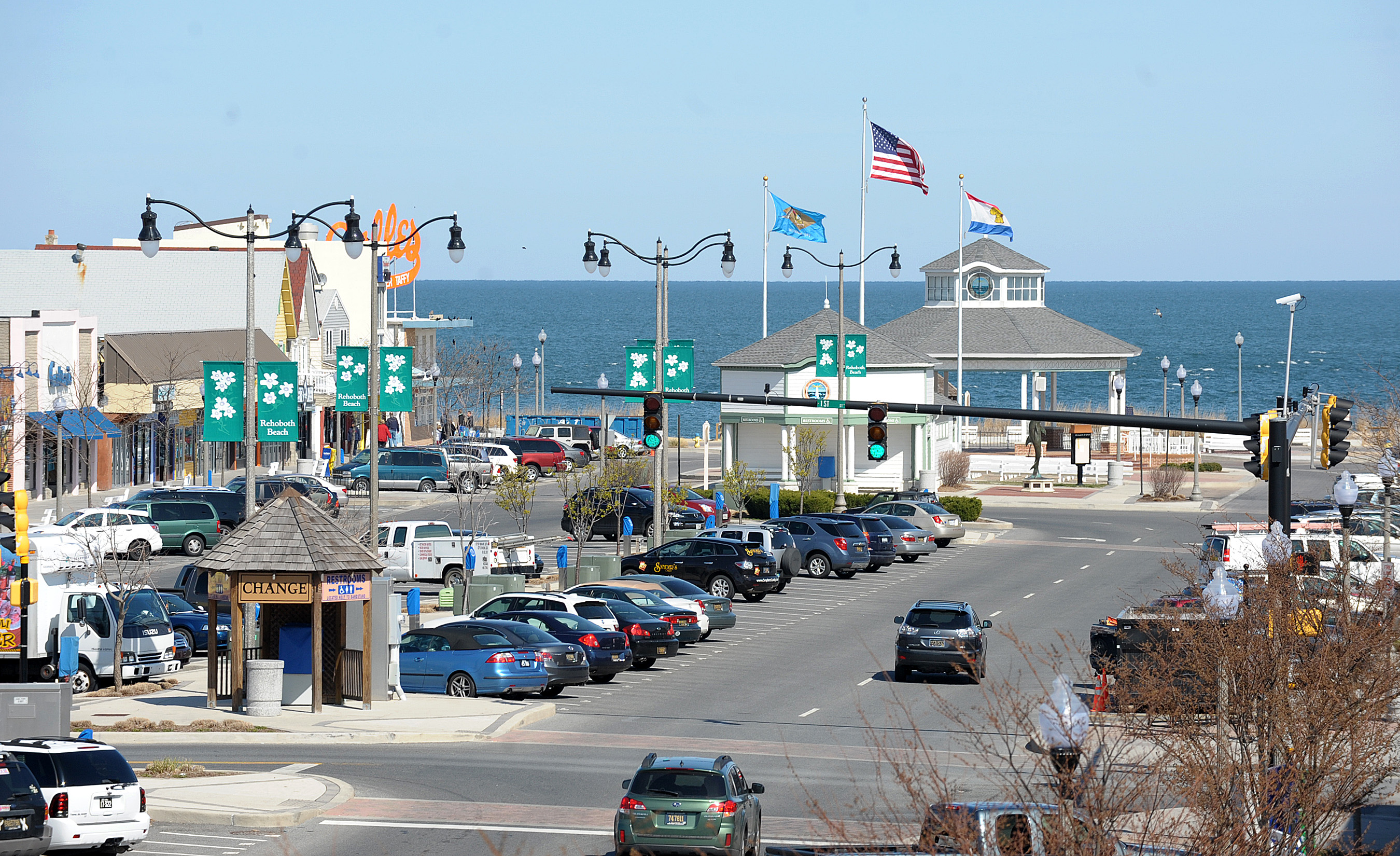
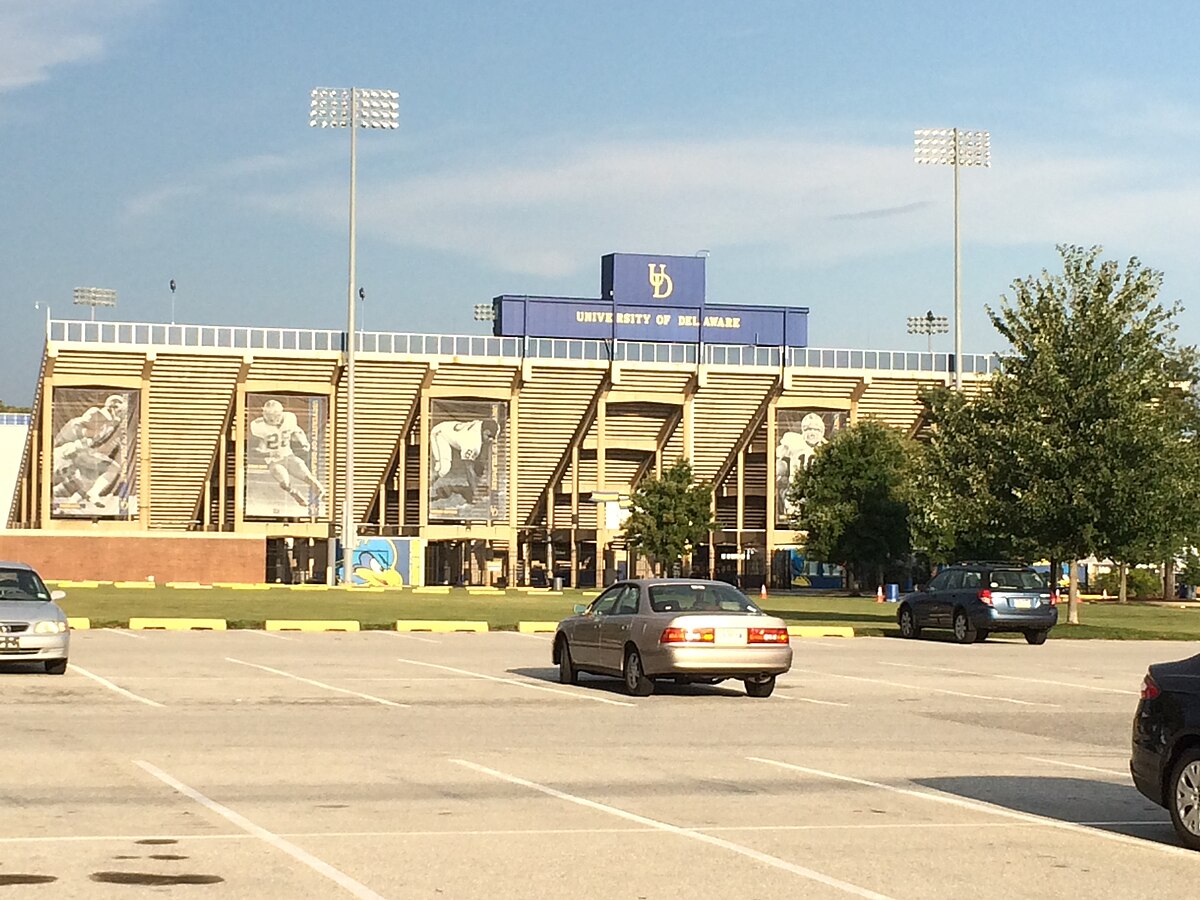
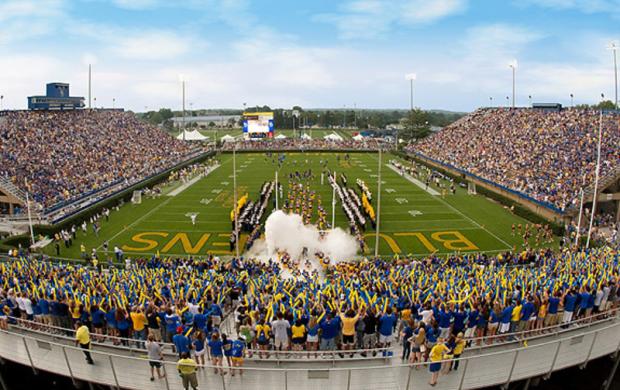

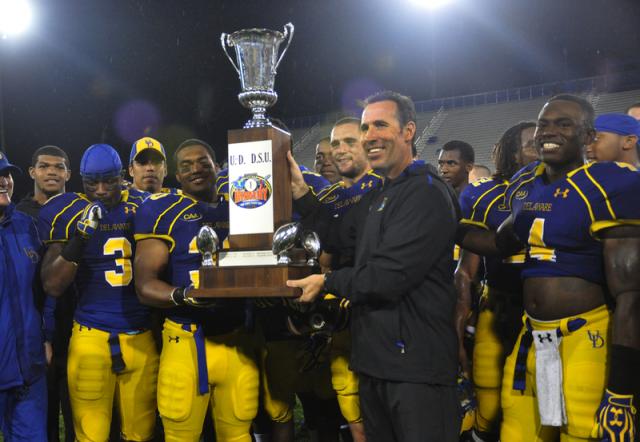
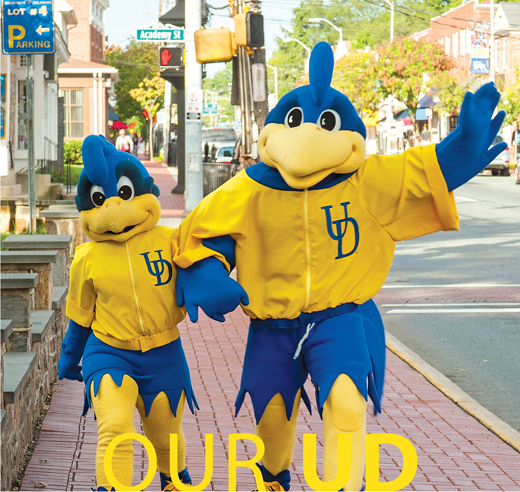
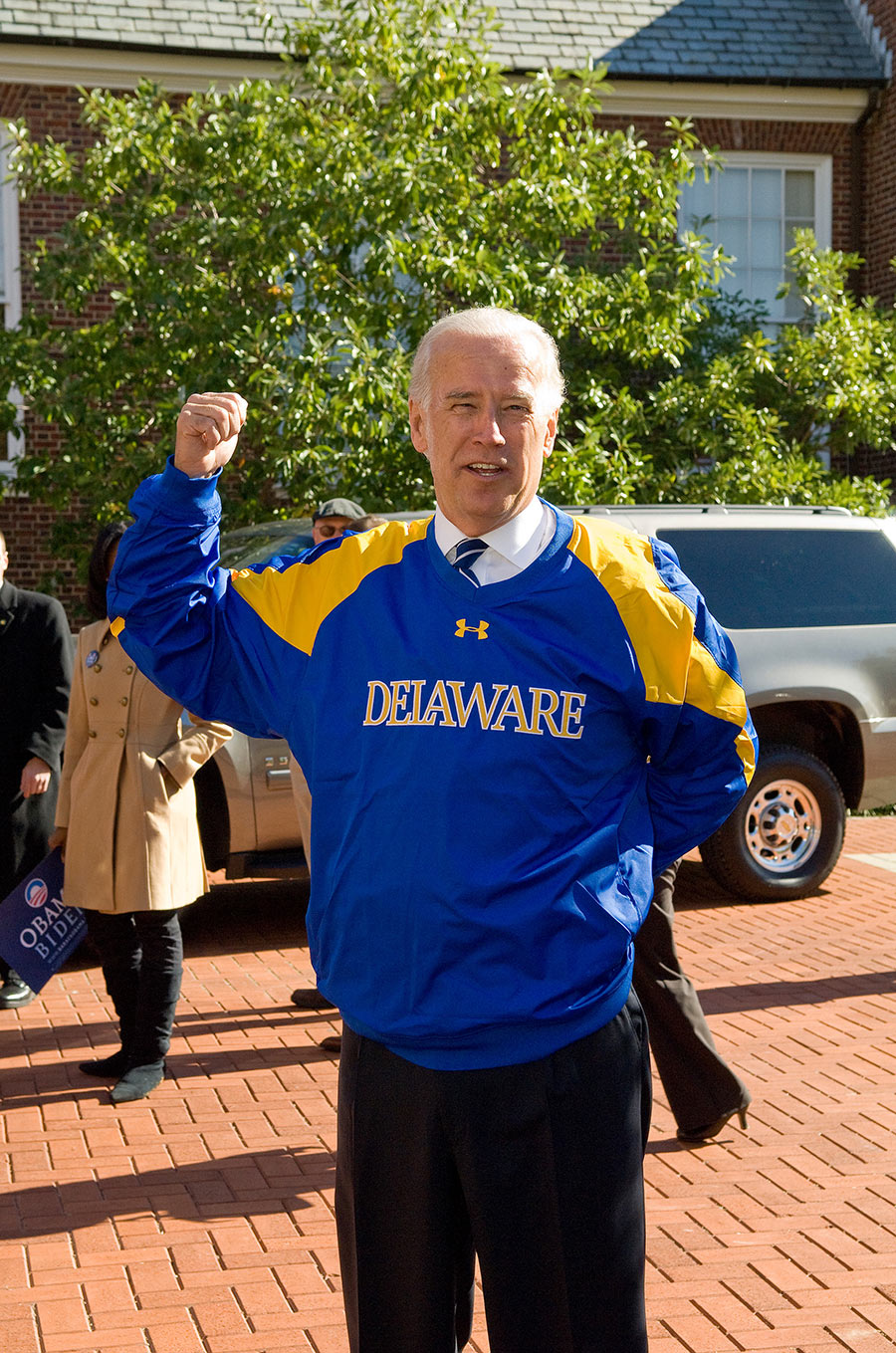

No comments:
Post a Comment